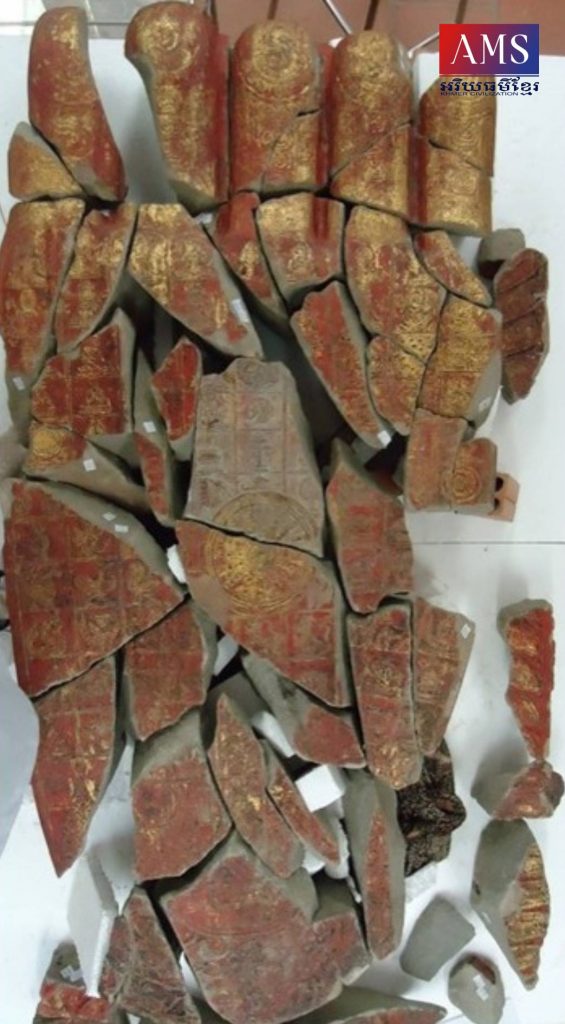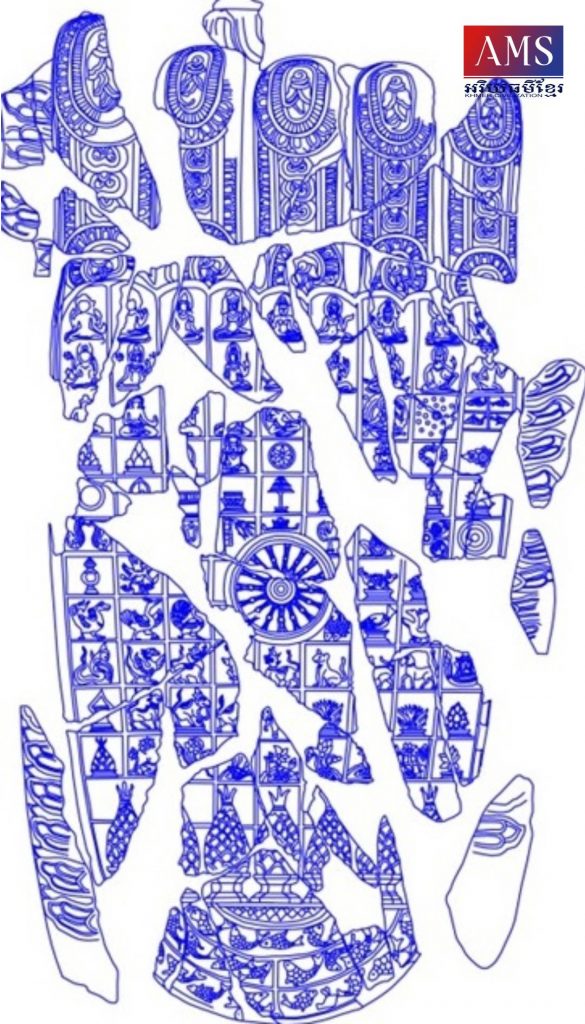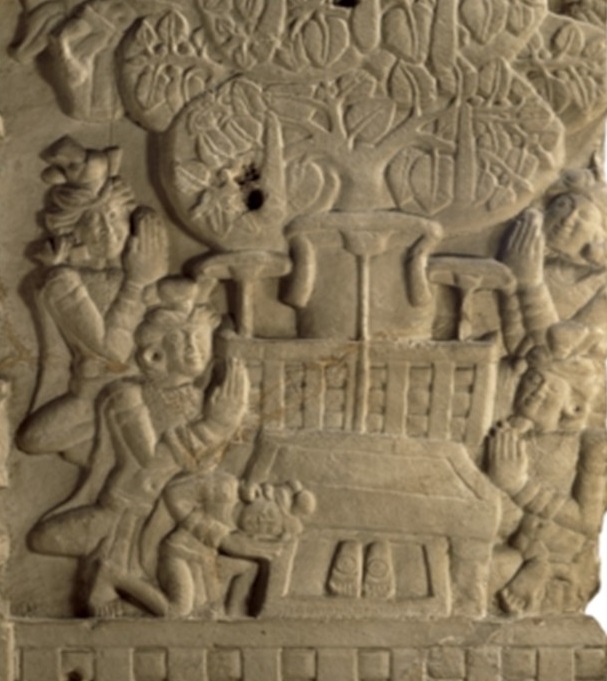ពុទ្ធសាសនិកជឿថា ព្រះពុទ្ធបាទ គឺបានបន្សល់ទុកដោយព្រះពុទ្ធសក្យមុនី បើទោះបីជាមានព្រះពុទ្ធជាច្រើនអង្គបានត្រាស់ និងចូលបរិនិព្វានក្តី។ ជាទូទៅគេឃើញមានចម្លាក់ និងគំនូរដែលទាក់ទងនឹងជើង ដូចជាព្រះពុទ្ធទ្រង់ដើរ៧ជំហ៊ាននៅលើផ្កាឈូកបន្ទាប់ពីព្រះអង្គបានប្រសូត ព្រះអង្គដើរនៅលើទឹកទន្លេនរញ្ញជនា ការចេញសាងព្រះផ្នួស និងការយាងចុះពីស្ថានត្រៃត្រឹង្ស។ នៅក្នុងសិល្បៈឥណ្ឌាជំនាន់ដើម ព្រះពុទ្ធមិនបានបង្ហាញក្នុងទម្រង់រូបរាងជាមនុស្សពេញលេញដូចក្នុងពេលបច្ចុប្បន្ននេះទេ។ វត្តមានរបស់ទ្រង់បង្ហាញក្នុងទម្រង់ជារូបតំណាង ដូចជាព្រះបាទ ដើមពោធិ ធម្មចក្រ បល្ល័ង្ក និងចេតីយ។ រូបតំណាងទាំងនេះបានបង្ហាញក្នុងសិល្បៈឥណ្ឌាក្នុងពេលដំណាលគ្នា។ ពុទ្ធបាទដំបូងៗ បានលេចឡើងលើចម្លាក់ចេតីយ នៅសាន់ឈី បារហ៊ូត និងនៅអមរាវាទី ឯស្រុកឥណ្ឌា។ តើហេតុអ្វីបានជាពុទ្ធសាសនិកនៅតែបន្តគោរពព្រះពុទ្ធបាទយ៉ាងខ្ជាប់ខ្ជួន បើប្រៀបធៀបទៅនឹងរូបតំណាងដទៃទៀត?
តាមប្រពៃណី ការគោរពបូជាដានជើង គឺមានទាំងក្នុងព្រហ្មញ្ញសាសនា និងព្រះពុទ្ធសាសនា ដូច្នេះត្រឹមតែទម្រង់ដានជើងទទេ គឺមិនអាចសន្និដ្ឋានថា ដានជើងនោះជាដានជើងរបស់ព្រះឥសូរ (ទេពក្នុងព្រហ្មញ្ញសាសនា) ឬដានជើងរបស់ព្រះពុទ្ធឡើយ។ ក៏ប៉ុន្តែបរិបទនៅជុំវិញ និងចំណេះដឹងរបស់សាសនិកអាចឱ្យគេកំណត់អត្តសញ្ញាណរបស់ព្រះបាទនោះបាន។ ជាទូទៅ នៅក្នុងសិល្បៈព្រះពុទ្ធសាសនាសម័យដើម គេឆ្លាក់ព្រះពុទ្ធបាទដោយមានកងចក្រ ប៉ុន្តែនៅក្នុងសម័យក្រោយមកទៀតបែរជានិយមបង្ហាញព្រះពុទ្ធបាទដែលមានសញ្ញាមង្គលទាំង១០៨ជំនួសវិញ។
រូបតំណាងរបស់ព្រះពុទ្ធបានបង្ហាញក្នុងចម្លាក់ដាច់ដោយឡែកពីគ្នា ប៉ុន្តែមានករណីខ្លះក៏បានបង្ហាញរួមជាមួយគ្នាក៏មាន។ ការបង្ហាញរូបតំណាងព្រះពុទ្ធនៅរួមគ្នាបង្ហាញឱ្យឃើញអំពីភាពសំខាន់ផ្សេងគ្នាយ៉ាងច្បាស់លាស់ គឺព្រះពុទ្ធបាទទទួលបានការគោរពយ៉ាងខ្លាំងបំផុត។ ក្នុងរូបភាពនេះបង្ហាញថា មនុស្សជាច្រើនបានគោរពរូបតំណាងផ្សេងៗរបស់ព្រះពុទ្ធ ប៉ុន្តែមានតែមនុស្សដែលគោរពព្រះពុទ្ធបាទប៉ុណ្ណោះ ដែលមានកាយវិការអោនលំទោនយ៉ាងខ្លាំង។
បើពិនិត្យទៅលើរូបតំណាងទាំង៥របស់ព្រះពុទ្ធ ពុទ្ធបាទ ដើមពោធិ បល្ល័ង្ក ធម្មចក្រ និងចេតីយ ឃើញថាមានរបស់បួនយ៉ាងដែលតំណាងឱ្យទីកន្លែង និងព្រឹត្តិការណ៍ដែលបានកើតឡើងក្នុងដំណើរជីវិតរបស់ព្រះអង្គ។ ដើមពោធិ តំណាងឱព្រះអង្គក្នុងពេលត្រាស់ដឹង។ បល្ល័ង្ក តំណាងឱ្យព្រះអង្គក្នុងពេលសំដែងធម្មទេសនានៅសារនាថ។ ធម្មចក្រតំណាងឱ្យព្រះធម៌ និងវាលវដ្តសង្សា រីឯចេតីយតំណាងឱ្យព្រះអង្គពេលដែលយាងចូលបរិនិព្វាន។ ដោយឡែក ពុទ្ធបាទ ឬស្នាមព្រះពុទ្ធបាទ ជាផ្នែកតែមួយគត់ដែលជាប់ទាក់ទងនឹងព្រះកាយរបស់ព្រះអង្គ។ ជាធម្មតាដានជើងមនុស្សម្នាក់ បញ្ជាក់អត្តសញ្ញាណរបស់មនុស្សនោះ ឬជាទូទៅសំដៅទៅលើមនុស្សនោះតែម្តង ដូច្នេះពុទ្ធបាទ គឺជារូបរបស់ព្រះពុទ្ធផ្ទាល់។
ក្នុងទស្សនៈព្រះពុទ្ធសាសនា ព្រះពុទ្ធមានព្រះកាយពីរ រូបកាយ និងធម្មកាយ។ រូបកាយរបស់ព្រះពុទ្ធបានចូលបរិនិព្វាន និងខន្ធទាំងអស់បានបែកខ្ទេចទៅតាមធម្មជាតិ ក៏ប៉ុន្តែធម្មកាយរបស់ព្រះអង្គគង់នៅជាធរមាន។ តាមរយៈព្រះធម្មទាំងឡាយដែលសាសនិកកំពុងប្រតិបត្តិ នាំឱ្យគេឃើញថាព្រះកាយរបស់ព្រះអង្គនៅមានវត្តមាននៅឡើយ។ ព្រះអង្គ មានរូបដែលមិនមែនជារូប គឺមានន័យថាទទេ ដែលជាទូទៅពុទ្ធសាសនិកធ្លាប់ស្គាល់ថាអនត្តា គឺមិនមែនជារបស់ចិត្ត របស់ខ្លួន ឬដែលគ្មានខ្លឹមសារ។ សរុបមកព្រះពុទ្ធបាទ គឺជាព្រះកាយរបស់ព្រះពុទ្ធក្នុងទម្រង់ជាមនុស្ស មុនពេលមានរូបរាងពេញលេញ គឺជាសរីរៈ ឬផ្នែកនៃរូបកាយ ឬជារូបកាយទាំងមូលរបស់ព្រះពុទ្ធតែម្តង។ វាជាទម្រង់ដែលមានសារសំខាន់បំផុតដែលពន្យល់ឱ្យឃើញអំពីការយល់ដឹងរបស់សិល្បករ និងពុទ្ធសាសនិកអំពីវត្តមាន និងអវត្តមានរបស់ព្រះពុទ្ធ និងព្រះធម៌។ អាស្រ័យដូចនេះហើយទើបពុទ្ធសាសនិកនៅតែបន្តកសាងព្រះពុទ្ធបាទដាក់តំកល់គោរពបូជា រួមជាមួយនឹងបដិមាព្រះពុទ្ធដែលមានទម្រង់ជាមនុស្សពេញលេញ។
———————————————-
The Belief on Buddha Footprint
Buddha footprint (Buddha-pāda/śri-pāda) is believed left by the Buddha Sakyamuni even there are many Buddha in the past. The famous scenes are the seven steps after he was born, walking on the waters of the river Nairañjana, great departure and the descent from Trāyasatriṃśa (33 heavens). However, it can be seen in various narratives. In early Indian Art, Buddha footprint is an aniconic symbol of Buddha. It appears on the relief at Sanchi, Barhut and Amaravati at the same time with the tree, the throne, the wheel and the stupa. As an emblem, Buddha footprint is an exceptional form that still famous for veneration.
Traditionally, the veneration of footprint does appear both Hinduism and Buddhism. Therefore, the contour or the shape of the foot could not tell if it is the foot of Lord Siva or the Buddha. However, the context and the auspicious symbols (Buddhapādamaṅgala) are the keys to identify them. In the early Buddhist Art, Buddha footprint has a Cakra (wheel) on his foot. In the later period, the foot has the auspicious symbols, and it can be up to 108. Additionally, there are also Buddha footprints without the auspicious symbol.
The value of Buddha footprint might consider as different from the tree, the throne, the wheel and the stupa. Even though these aniconic symbols represent the presence of Buddha but it might be not related to the physical body of the Buddha. Here, Darśana of Buddhist toward the Buddha himself might be slightly important than the other aniconic forms. The footprint is much more critical if they are in combination with the others. In this relief, the devotees venerate the tree, the throne and the foot. However, only one devotee who venerates the foot is bending his body very low. Therefore, to some extent there might be a hierarchy between those aniconic forms.
In Buddhism, the notion of Anatta (no-soul) well known by the Buddhist. They do know the Buddha attained Nirvana. He is ‘a being who is a non-being’ meaning nothing. However, Buddha has Rūpakāya (body) and Dharmakāya. The body of Buddha has gone but his Dharmakāya alive within the Buddhist. Even though Dharmakaya usually understands as the Buddha’s teaching, but through his teaching he is alive.
In conclusion, Buddha’s footprint might be not fully an aniconic symbol of Buddha but probably an early anthropomorphic form of Buddha. It is a Buddha or the portrait of Buddha himself. It is a śariraka and the Rūpakāya within the Dharmakāya. This form is essential to explain that the artist and the Buddhist at the early time understand clearly the absence and the presence of Buddha and Dharma. It is probably also the reason why the Buddha footprint is still producing, installing, and worshipping together with the statues of Buddha up to the present.
អត្ថបទដើម៖ កញ្ញា មាស សុភាព









